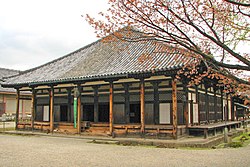| UNESCO World Heritage Site | |
|---|---|
 Great Buddha Hall of Todaiji | |
| Location | Nara Prefecture, Kansai region, Japan |
| Criteria | Cultural: (ii), (iii), (iv), (vi) |
| Reference | 870 |
| Inscription | 1998 (22nd Session) |
| Area | 617 ha (1,520 acres) |
| Buffer zone | 1,962.5 ha (4,849 acres) |
| Coordinates | 34°40′32″N135°50′22″E / 34.67556°N 135.83944°E |
Historic Monuments of Ancient Nara is a UNESCO World Heritage Site consisting of eight places in the old capital Nara in Nara Prefecture, Japan. Five are Buddhist temples, one is a Shinto shrine, one is a Palace and one a primeval forest. The properties include 26 buildings designated by the Japanese Government as National Treasures as well as 53 designated as Important Cultural Properties. All compounds have been recognized as Historic Sites. The Nara Palace Site was designated as Special Historic Site and the Kasugayama Primeval Forest as Special Natural Monument. Tōdai-ji, Kōfuku-ji and the Kasugayama Primeval Forest overlap with Nara Park, a park designated as one of the "Places of Scenic Beauty" by the Ministry of Education, Culture, Sports, Science and Technology (MEXT). UNESCO listed the site as World Heritage in 1998. [1] [2]









